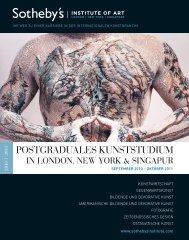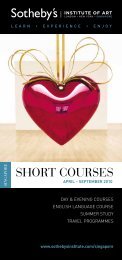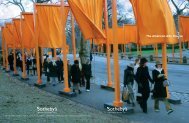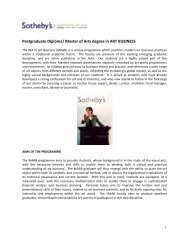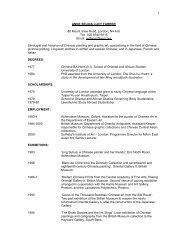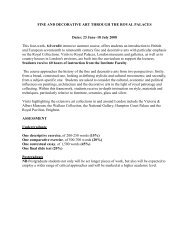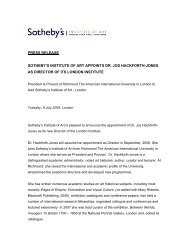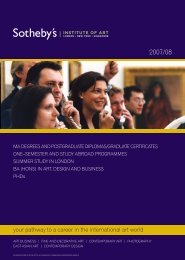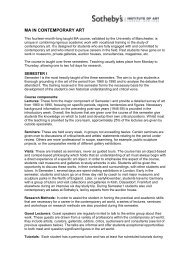Zones of Indistinction: Giorgio Agamben's Bare Life and
Zones of Indistinction: Giorgio Agamben's Bare Life and
Zones of Indistinction: Giorgio Agamben's Bare Life and
You also want an ePaper? Increase the reach of your titles
YUMPU automatically turns print PDFs into web optimized ePapers that Google loves.
CTTE_A_384228.fm Page 110 Sunday, April 26, 2009 1:30 PM<br />
110<br />
1 Currently pr<strong>of</strong>essor <strong>of</strong><br />
aesthetics at the University<br />
<strong>of</strong> Verona, <strong>Giorgio</strong><br />
Agamben has progressed<br />
his theory <strong>of</strong> homo sacer,<br />
sovereignty <strong>and</strong> ‘states <strong>of</strong><br />
exception’ in, respectively,<br />
Homo Sacer: Sovereign<br />
Power <strong>and</strong> <strong>Bare</strong> <strong>Life</strong>,<br />
Stanford University Press,<br />
Stanford, [1995] 1998,<br />
hereafter referred to as HS<br />
followed by page number,<br />
<strong>and</strong> State <strong>of</strong> Exception,<br />
Chicago University Press,<br />
Chicago, [2003] 2005.<br />
Agamben’s use <strong>of</strong> the<br />
phrase ‘bare life’ is related<br />
to the Greek term zoe <strong>and</strong><br />
Hannah Arendt’s<br />
description <strong>of</strong> the refugee’s<br />
‘naked life’ in The Origins<br />
<strong>of</strong> Totalitarianism (1951).<br />
The phrase also has a<br />
counterpart in Walter<br />
Benjamin’s use <strong>of</strong> ‘bare life’<br />
(bloßes Leben) in ‘Critique<br />
<strong>of</strong> Violence’ (1921). The<br />
term ‘bare life’, as opposed<br />
to the literal Italian<br />
translation ‘naked life’<br />
used in the original version<br />
<strong>of</strong> the book, has been<br />
largely adopted by<br />
translators <strong>and</strong><br />
commentators alike.<br />
to ‘bare life’ by sovereign decree <strong>and</strong> deprived <strong>of</strong> basic rights such as<br />
representation before the law. 1 Homo sacer, the sacred <strong>and</strong> therefore<br />
separate man – he who is set apart from others by law – is, for<br />
Agamben, the increasingly nascent figure <strong>of</strong> our times; a time in which<br />
we are witnessing the effective re-emergence <strong>of</strong> sovereign forms <strong>of</strong><br />
power <strong>and</strong> the concomitant production <strong>of</strong> ‘bare life’ as a constituent<br />
element in the democratic order. It is to Agamben’s credit that he does<br />
not propose a discrete topology <strong>of</strong> victimhood in his thesis; rather, he is<br />
suggesting that the discretionary ability <strong>of</strong> the sovereign state to bring<br />
the weight <strong>of</strong> its unmediated power to bear upon the body <strong>of</strong> its<br />
subjects is an inherent part <strong>of</strong> living in a democracy. In Agamben’s eyes,<br />
in fine, we are not only all potentially homo sacer (homines sacri) <strong>and</strong><br />
the de facto bearers <strong>of</strong> ‘bare life’ but this exceptional figure augurs a<br />
‘coming community’ that is based not on rights as such but the suspension<br />
<strong>of</strong> rights.<br />
To date, Agamben’s writings have been largely confined to issues <strong>of</strong><br />
governmentality, international law, human rights <strong>and</strong> state power. In<br />
what follows, I will extend those discussions <strong>and</strong> suggest that his thesis<br />
has significant purchase when it comes to considering various developments<br />
in contemporary art practice. To this end, my discussion is made<br />
up <strong>of</strong> two interrelated parts. The first outlines Agamben’s theorisation<br />
<strong>of</strong> political exceptionalism, ‘bare life’ <strong>and</strong> the ‘zones <strong>of</strong> indistinction’<br />
wherein homo sacer resides. The second part, in so far as it outlines a<br />
possible framework within which to explore the politics <strong>of</strong> aesthetics<br />
involved in representing ‘bare life’ <strong>and</strong> ‘zones <strong>of</strong> indistinction’, is <strong>of</strong><br />
necessity more speculative. In this latter context, it is critical that I note<br />
from the outset that the choice <strong>of</strong> artists discussed here is neither<br />
exhaustive nor predicated upon their utilitarian deployment <strong>of</strong> art as<br />
protest, propag<strong>and</strong>a or agitprop; on the contrary, it is the politics <strong>of</strong> the<br />
aesthetic that interests me here – the form that the work takes <strong>and</strong> the<br />
irreducible fact that these works circulate as part <strong>of</strong> a broader visual<br />
culture. If Agamben is indeed right when he argues that ‘states <strong>of</strong> exception’<br />
have increasingly become the norm in Western democracies, <strong>and</strong><br />
that we are seeing the re-emergence <strong>of</strong> sovereign power structures, not<br />
to mention the implications for the political subject <strong>and</strong> his/her legal<br />
status, then the ‘zones <strong>of</strong> indistinction’ in which we find modern-day<br />
homo sacer are in need <strong>of</strong> urgent representation. The question that is<br />
being posited here is therefore a relatively perennial one inasmuch as it<br />
concerns the extent to which aesthetic practices are responsive to the<br />
sociopolitical, economic, historical <strong>and</strong> cultural dimensions <strong>of</strong> the<br />
moment in which they are produced, discussed, exchanged <strong>and</strong><br />
displayed.<br />
POLITICAL EXCEPTIONALISM,<br />
HOMO SACER AND ‘BARE LIFE’<br />
Although Agamben’s work covers topics as diverse as aesthetics <strong>and</strong><br />
anthropogenesis, the two subjects he has been most associated with to<br />
date are sovereign power <strong>and</strong> homo sacer. Sovereignty is not to be necessarily<br />
equated here solely with historical ideals <strong>of</strong> monarchical power<br />
(although that is where the model for modern versions <strong>of</strong> sovereign



